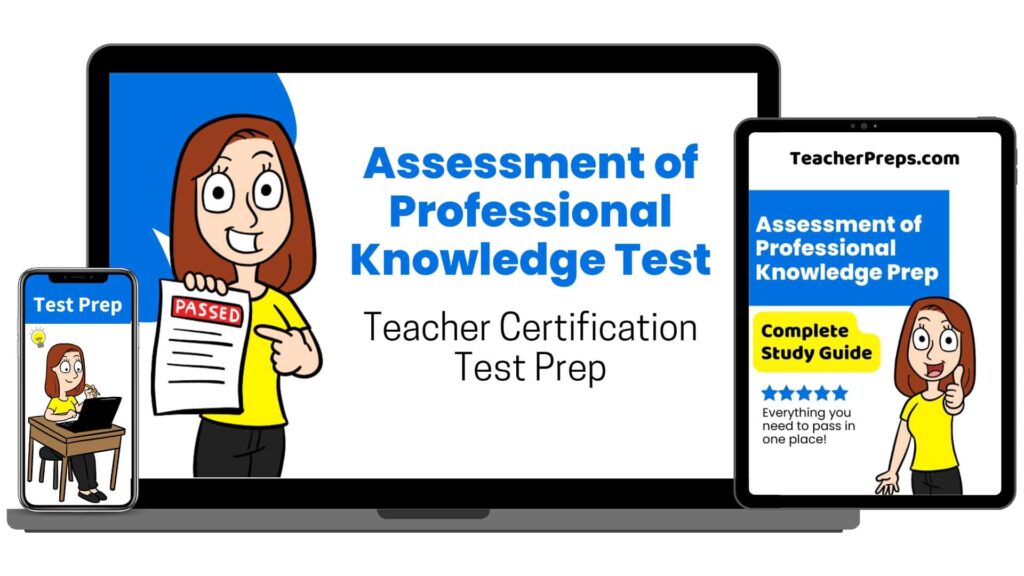
Assessment of Professional Knowledge Essay Workshop
How To Write a Passing Response
Introduction
If you’re feeling apprehensive about the essay section of the Assessment of Professional Knowledge: Primary Education (PK–5), don’t sweat it! Our test prep platform is designed to equip you with the essential framework needed to craft a passing response. Starting right here, we’ll walk you through the basics, and even showcase an example essay to guide you. Plus, our cutting-edge AI model is trained using the same rubric as the official testing agency, enabling you to write real essays and receive immediate scoring and feedback.
Understanding the Constructed Response Assignments
The essay or constructed response assignments on your test are pivotal in demonstrating your depth of understanding and ability to apply your knowledge in practical scenarios. Here’s what you need to know:
Criterion-Referenced Assessments:
- These essays measure your ability against a fixed standard or criterion.
- Your performance is evaluated based on your knowledge and skills, not by comparing you to other test takers.
Alignment with Standards:
- Essays are meticulously aligned with state standards, encompassing Educational Preparation Standards, Educator Standards, and Student Standards.
- This alignment ensures that your responses should reflect a thorough understanding of these standards.
Computer-Based Format:
- All constructed response assignments are completed on a computer.
- Familiarizing yourself with typing and organizing your thoughts digitally is crucial.
Test Duration and Preparation:
- There is a total of 2 constructed-response assignments:
- Work Product (10% of score)
- Case Study (10% of score)
- Each session begins with a 15-minute tutorial on computer-based testing, helping you settle in without the pressure of the clock.
- There is a total of 2 constructed-response assignments:
What to Expect and How to Excel
Essay Framework:
- Introduction: Set the stage for your discussion.
- Body: Dive deep into your arguments, supported by examples from the standards.
- Conclusion: Summarize your insights and reinforce your thesis.
Scoring Rubric:
- Understanding of the subject matter.
- Ability to integrate theory with practice.
- Clarity of expression and logical structure.
- Adherence to the educational standards.
AI-Powered Feedback:
- After submitting your essays through our platform, receive instant feedback on various aspects of your writing.
- Use this feedback to refine your approach, focus on areas of improvement, and enhance your writing skills.
By engaging with our Essay Workshop, you’re not just preparing to pass; you’re setting the foundation for impactful teaching and educational leadership. Get started today and transform your test anxiety into essay mastery!
How To Ace Your Essay
Start by understanding the scoring rubric
| Score Point | Score Point Description |
|---|---|
| 4 | A score of "4" indicates a comprehensive understanding and application of the relevant content and skills. The response is complete, accurate, and integrates strong, pertinent evidence along with specific, well-reasoned examples and explanations. |
| 3 | A score of "3" represents a good grasp of the necessary content and skills. The response covers most or all assignment components, with generally accurate and effective application, supported by adequate evidence and logical explanations. |
| 2 | A score of "2" signifies a partial understanding with limited application of the content knowledge and skills. Responses address some assignment components, offering limited evidence and examples that may not fully align with the required explanations. |
| 1 | A score of "1" demonstrates minimal or no comprehension of the required content and skills, addressing few assignment components. It shows largely inaccurate and ineffective application, with weak or inappropriate evidence and explanations. |
| U | The response cannot be scored ("U") if it is unreadable, off-topic, written in a non-English language, or lacks sufficient original content for evaluation. |
| B | A "B" indicates that no response was provided. |
This section of the test includes two constructed-response assignments: 1. one work product assignment and 2. one case study, which comprises three parts. You are required to prepare a written response of approximately 150–250 words for each assignment. Please read each assignment thoroughly before beginning to type. Each assignment will appear on your screen alongside an answer box where you should type your response. Your responses will be evaluated based on how effectively you communicate a complete message to the intended audience for the specified purpose. You will be assessed on your ability to apply professional knowledge in your responses. Evaluation of your response will consider the following criteria: Make sure to write about the assigned topic. No reference materials are allowed, and your response must be your original work, written in your own words. Avoid copying or paraphrasing from other works. Before finalizing your response, review and revise it to enhance its quality. Your final response should adhere to the conventions of edited American English. For the task below, choose a grade level and content area you are prepared to teach, and write a response of approximately 150–250 words in which you:Directions for the Constructed-Response Assignments
Sample Work Product Assignment
Provide opportunities to integrate critical thinking skills into instructional activities throughout the curriculum for students;
Explain why integrating critical thinking skills in lesson design enhances students' understanding and learning across the content areas;
Describe one strategy or method that you could use to support critical thinking during instruction that would promote student learning in the content you identified;
Explain why this strategy or method would be effective in promoting students' learning and achievement.
Get feedback on your practice essays
Study smarter, build your confidence, and pass on your next try!
Use the case study below to complete the assignment that follows. A fourth-grade class is learning a science unit focused on ecosystems. The lesson begins with a quick-draw activity, where students sketch an ecosystem element (like a plant or animal) they learned about from the previous lesson. Each student has five minutes for this activity, and they are encouraged to think about how their chosen element interacts within the ecosystem. During the independent activity, the teacher circulates the room, observing the students’ drawings, offering encouragement, and answering questions. After the quick-draw, the teacher introduces the next activity: students will pair up and share their drawings. Each pair will discuss how their chosen elements interact with each other in an ecosystem, and they will write a joint summary on a shared piece of paper. The teacher reminds them that effective feedback is clear, constructive, and kind. Students engage in the peer feedback session for five minutes, while the teacher listens in and provides guidance as needed. The teacher wants to explore additional methods of peer-assessment to further evaluate students' understanding and engagement with the science concepts. After reviewing the information provided, write a response of approximately 150–250 words in which you:Sample Case Study Assignment

